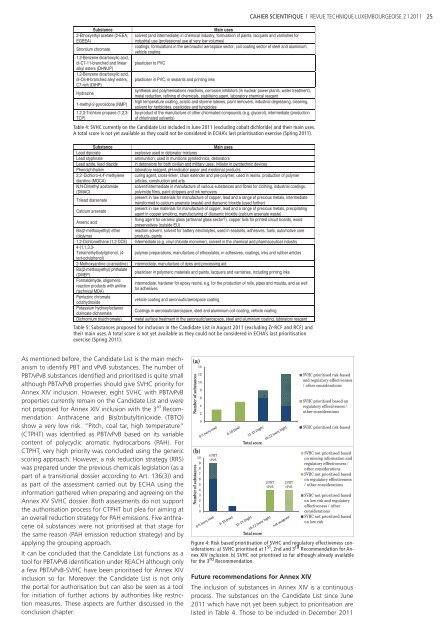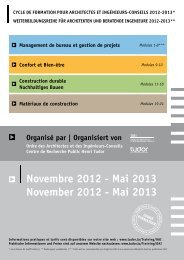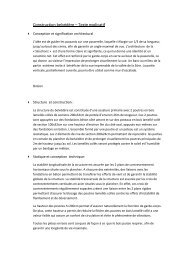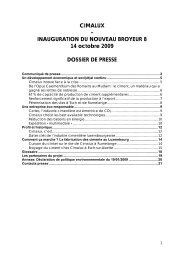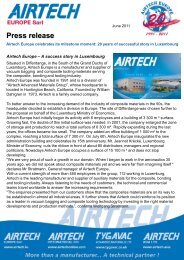Cahier Scientifique 02 | 2011 (PDF) - Revue Technique ...
Cahier Scientifique 02 | 2011 (PDF) - Revue Technique ...
Cahier Scientifique 02 | 2011 (PDF) - Revue Technique ...
Create successful ePaper yourself
Turn your PDF publications into a flip-book with our unique Google optimized e-Paper software.
CAHIER SCIENTIFIQUE | REVUE TECHNIQUE LUXEMBOURGEOISE 2 | <strong>2011</strong><br />
25<br />
Substance<br />
2-Ethoxyethyl acetate (2-EEA,<br />
EGEEA)<br />
Strontium chromate<br />
1,2-Benzene dicarboxylic acid,<br />
di-C7-11-branched and linear<br />
alkyl esters (DHNUP)<br />
1,2-Benzene dicarboxylic acid,<br />
di-C6-8-branched alkyl esters,<br />
C7-rich (DIHP)<br />
Hydrazine<br />
1-methyl-2-pyrrolidone (NMP)<br />
1,2,3-Trichloro propane (1,2,3-<br />
TCP)<br />
Substance<br />
Lead dipicrate<br />
Lead styphnate<br />
Lead azide, lead diazide<br />
Phenolphthalein<br />
2,2'-Dichloro-4,4'-methylene<br />
dianiline (MOCA)<br />
N,N-Dimethyl acetamide<br />
(DMAC)<br />
Trilead diarsenate<br />
Calcium arsenate<br />
Arsenic acid<br />
Bis(2-methoxyethyl) ether<br />
(diglyme)<br />
1,2-Dichloroethane (1,2-DCE)<br />
4-(1,1,3,3-<br />
Tetramethylbutyl)phenol, (4-<br />
tert-octylphenol)<br />
2-Methoxyaniline (o-anisidine)<br />
Bis(2-methoxyethyl) phthalate<br />
(DMEP)<br />
Formaldehyde, oligomeric<br />
reaction products with aniline<br />
(technical MDA)<br />
Pentazinc chromate<br />
octahydroxide<br />
Potassium hydroxyloctaoxo<br />
dizincate dichromate<br />
Dichromium tris(chromate)<br />
Main uses<br />
solvent (and intermediate) in chemical industry, formulation of paints, lacquers and varnishes for<br />
industrial use (professional use at very low volumes)<br />
coatings, formulations in the aeronautic/ aerospace sector, coil coating sector of steel and aluminium,<br />
vehicle coating<br />
plasticiser to PVC<br />
plasticiser in PVC, in sealants and printing inks<br />
synthesis and polymerisations reactions, corrosion inhibitors (in nuclear power plants, water treatment),<br />
metal reduction, refining of chemicals, stabilising agent, laboratory chemical reagent<br />
high temperature coating, acrylic and styrene latexes, paint removers, industrial degreasing, cleaning,<br />
solvent for herbicides, pesticides and fungicides<br />
by-product of the manufacture of other chlorinated compounds (e.g. glycerol), intermediate (production<br />
of chlorinated solvents)<br />
Table 4: SVHC currently on the Candidate List included in June <strong>2011</strong> (excluding cobalt dichloride) and their main uses.<br />
A total score is not yet available as they could not be considered in ECHA’s last prioritisation exercise (Spring <strong>2011</strong>).<br />
Main uses<br />
explosive used in detonator mixtures<br />
ammunition, used in munitions pyrotechnics, detonators<br />
in detonators for both civilian and military uses, initiator in pyrotechnic devices<br />
laboratory reagent, pH-indicator paper and medicinal products<br />
curing agent, cross-linker, chain extender and pre-polymer, used in resins, production of polymer<br />
articles, construction and arts<br />
solvent/intermediate in manufacture of various substances and fibres for clothing, industrial coatings,<br />
polyimide films, paint strippers and ink removers<br />
present in raw materials for manufacture of copper, lead and a range of precious metals, intermediate<br />
transformed to calcium arsenate (waste) and diarsenic trioxide (used further)<br />
present in raw materials for manufacture of copper, lead and a range of precious metals, precipitating<br />
agent in copper smelting, manufacturing of diarsenic trioxide (calcium arsenate waste)<br />
fining agent for ceramic glass (artisanal glass sector?), copper foils for printed circuit boards, wood<br />
preservatives (outside EU)<br />
reaction solvent, solvent for battery electrolytes, used in sealants, adhesives, fuels, automotive care<br />
products, paints<br />
Intermediate (e.g. vinyl chloride monomer), solvent in the chemical and pharmaceutical industry<br />
polymer preparations, manufacture of ethoxylates, in adhesives, coatings, inks and rubber articles<br />
intermediate, manufacture of dyes and processing aid<br />
plasticiser in polymeric materials and paints, lacquers and varnishes, including printing inks<br />
intermediate, hardener for epoxy resins, e.g. for the production of rolls, pipes and moulds, and as well<br />
for adhesives<br />
vehicle coating and aeronautic/aerospace coating<br />
Coatings in aeronautic/aerospace, steel and aluminium coil coating, vehicle coating<br />
metal surface treatment in the aeronautic/aerospace, steel and aluminium coating, laboratory reagent<br />
Table 5: Substances proposed for inclusion in the Candidate List in August <strong>2011</strong> (excluding Zr-RCF and RCF) and<br />
their main uses. A total score is not yet available as they could not be considered in ECHA’s last prioritisation<br />
exercise (Spring <strong>2011</strong>).<br />
As mentioned before, the Candidate List is the main mechanism<br />
to identify PBT and vPvB substances. The number of<br />
PBT/vPvB substances identified and prioritised is quite small<br />
although PBT/vPvB properties should give SVHC priority for<br />
Annex XIV inclusion. However, eight SVHC with PBT/vPvB<br />
properties currently remain on the Candidate List and were<br />
not proposed for Annex XIV inclusion with the 3 rd Recommendation:<br />
Anthracene and Bis(tributyltin)oxide (TBTO)<br />
show a very low risk. “Pitch, coal tar, high temperature”<br />
(CTPHT) was identified as PBT/vPvB based on its variable<br />
content of polycyclic aromatic hydrocarbons (PAH). For<br />
CTPHT, very high priority was concluded using the generic<br />
scoring approach. However, a risk reduction strategy (RRS)<br />
was prepared under the previous chemicals legislation (as a<br />
part of a transitional dossier according to Art. 136(3)) and<br />
as part of the assessment carried out by ECHA using the<br />
information gathered when preparing and agreeing on the<br />
Annex XV SVHC dossier. Both assessments do not support<br />
the authorisation process for CTPHT but plea for aiming at<br />
an overall reduction strategy for PAH emissions. Five anthracene<br />
oil substances were not prioritised at that stage for<br />
the same reason (PAH emission reduction strategy) and by<br />
applying the grouping approach.<br />
It can be concluded that the Candidate List functions as a<br />
tool for PBT/vPvB identification under REACH although only<br />
a few PBT/vPvB-SVHC have been prioritised for Annex XIV<br />
inclusion so far. Moreover the Candidate List is not only<br />
the portal for authorisation but can also be seen as a tool<br />
for initiation of further actions by authorities like restriction<br />
measures. These aspects are further discussed in the<br />
conclusion chapter.<br />
(a)<br />
Numberofsubstances<br />
14<br />
12<br />
10<br />
(b)<br />
Numberofsubstances<br />
8<br />
6<br />
4<br />
2<br />
0<br />
10<br />
9<br />
8<br />
7<br />
6<br />
5<br />
4<br />
3<br />
2<br />
1<br />
0<br />
4PBT<br />
vPvB<br />
Totalscore<br />
Totalscore<br />
2PBT<br />
vPvB<br />
2PBT<br />
vPvB<br />
SVHCprioritisedriskbased<br />
andregulatoryeffectiveness<br />
/otherconsiderations<br />
SVHCprioritisedbasedon<br />
regulatoryeffectiveness/<br />
otherconsiderations<br />
SVHCprioritisedriskbased<br />
SVHCnotprioritisedbased<br />
onmissinginformationand<br />
regulatoryeffectiveness/<br />
otherconsiderations<br />
SVHCnotprioritisedbased<br />
onregulatoryeffectiveness<br />
/otherconsiderations<br />
SVHCnotprioritisedbased<br />
onlowriskandregulatory<br />
effectiveness/other<br />
considerations<br />
SVHCnotprioritisedbased<br />
onlowrisk<br />
Figure 4: Risk based prioritisation of SVHC and regulatory effectiveness considerations:<br />
a) SVHC prioritised at 1 st , 2nd and 3 rd Recommendation for Annex<br />
XIV inclusion. b) SVHC not prioritised so far although already available<br />
for the 3 rd Recommendation.<br />
Future recommendations for Annex XIV<br />
The inclusion of substances in Annex XIV is a continuous<br />
process. The substances on the Candidate List since June<br />
<strong>2011</strong> which have not yet been subject to prioritisation are<br />
listed in Table 4. Those to be included in December <strong>2011</strong>


